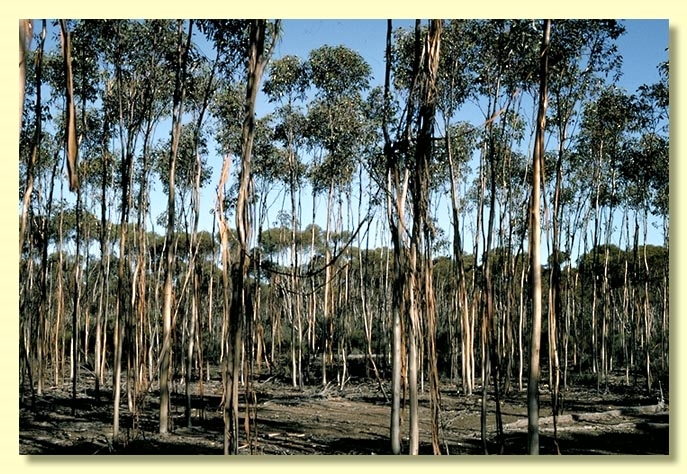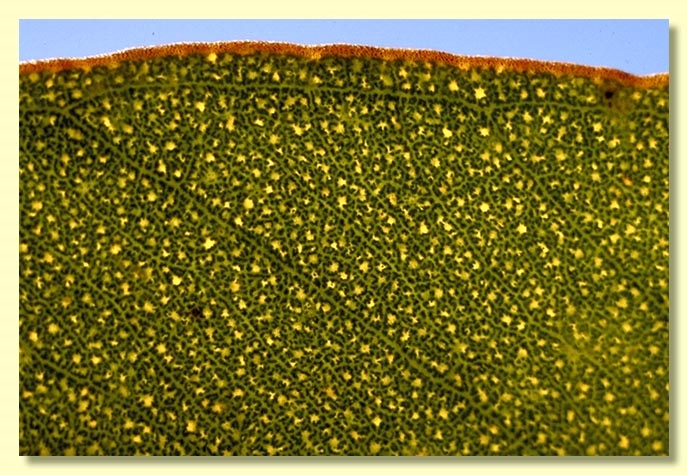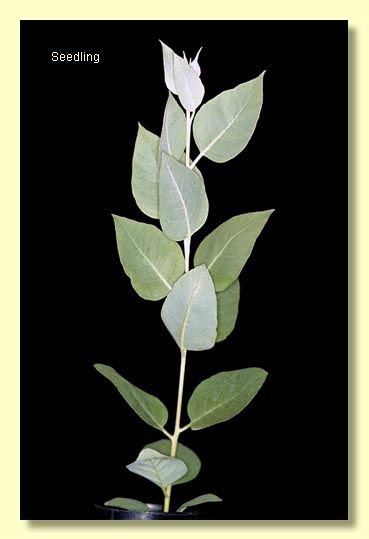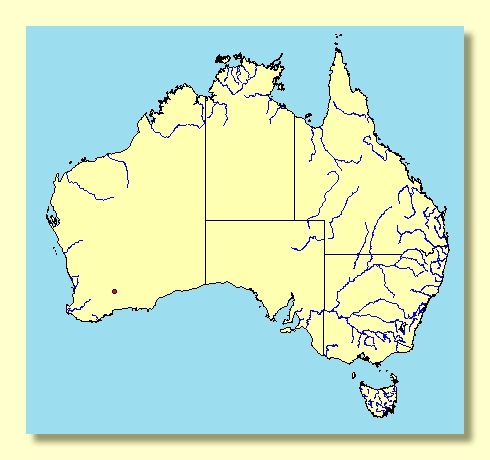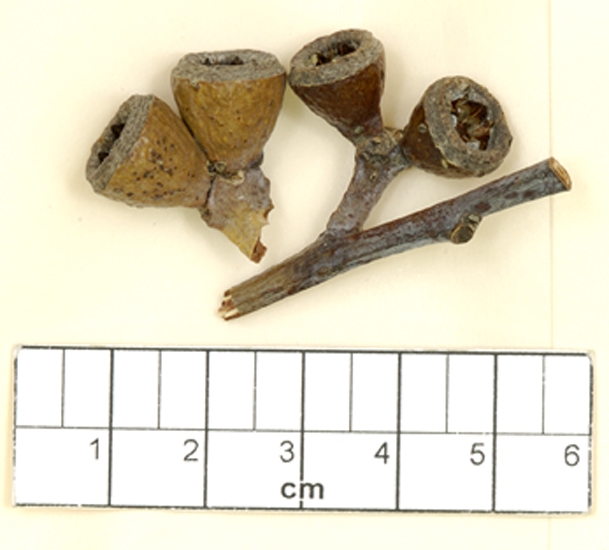Eucalyptus | Symphyomyrtus | Dumaria | Rufispermae
Euclid - Online edition
Eucalyptus georgei subsp. fulgida
Bark smooth throughout, pale grey and coppery-orange, shedding in long ribbons.
Branchlets very glaucous, oil glands present in the pith.
Juvenile growth (coppice or field seedlings to 50 cm): stems square to rounded in cross-section, glaucous; juvenile leaves always petiolate, alternate, ovate to broadly lanceolate, 6–8 cm long, 2–5 cm wide, base tapering, rounded or truncate, glaucous.
Adult leaves alternate, petioles 2.5–4.2 cm long; blade lanceolate, 10–20 cm long, 1.5–4 cm wide, base tapering to petiole, margin entire, apex pointed, glossy, green, side-veins at an acute or wider angle to midrib, reticulation very dense, intramarginal vein close to margin, oil glands intersectional.
Inflorescence axillary unbranched, peduncles stout, glaucous, 1–2.7 cm long, buds 7, 9 or 11 per umbel, pedicellate, pedicels 0.4 cm long. Mature buds obovoid to pyriform (ca 1 cm long, 0.7–0.8 cm wide), glaucous, scar present, operculum conical or rounded (ca 0.4 cm long), sometimes apiculate, equal to or slightly narrower than hypanthium at the join, radially striate or not, stamens inflexed, anthers cuboid to wedge-shaped, versatile, sub-dorsifixed, dehiscing by longitudinal slits, style long and straight, stigma rounded to tapering, locules 4 or 5, the placentae each with 4 vertical rows of ovules. Flowers creamy white.
Fruit pedicellate, pedicels 0.3–0.7 cm long, obconical to cupular or slightly campanulate, 0.8–1.2 cm long, 0.8–1.1(1.4) cm wide, usually glaucous, disc descending, valves 4 or 5, near rim level.
Seeds reddish brown and glossy, 1.5–3 mm long, flattened-ovoid and often slightly angular in outline, dorsal surface shallowly reticulate, hilum ventral.
Cultivated seedlings (measured at ca node 10): cotyledons reniform; stems square to rounded in cross-section, glaucous; leaves always petiolate, opposite for 3 to 5 nodes then alternate, ovate, 6–8.5 cm long, 3–6 cm wide, coarse, thick, slightly glaucous to greenish.
Flowering time unknown.
Eucalyptus georgei is a small tree (mallet) species endemic to Western Australia, restricted to a few localities between Hyden and Norseman and disjunctly from the Fraser Range area east of Norseman. The bark is smooth and sheds characteristically in long ribbons that remain hanging from the crown and down the trunk.
In the classification of Brooker (2000) Eucalyptus georgei belongs in Eucalyptus subgenus Symphyomyrtus section Dumaria having these features: buds initially with two opercula the outer shed early, stamens strongly inflexed, ovules in 4 rows on the placentae and cotyledons reniform. Within section Dumaria the species belongs to a large sub-group of closely related species (series Rufispermae, 37 described species and subspecies) diagnosed by glandular pith in the branchlets, anthers cuboid to wedge-shaped, versatile, and by the reddish brown and glossy, flattish seeds which are unique to the series.
In the general area between Mt Day, Norseman and Balladonia the large-fruited species of series Rufispermae most likely to be confused with E. georgei is E. lesouefii which, like E. georgei, has waxy branchlets, buds and fruits but is rough-butted and has ribbed buds and fruit. Other large-fruited tree species in this group, and likely to be encountered in this area, are non-glaucous (E. fraseri, E. tenuis, E. distuberosa and E. pterocarpa) and in some cases are also ribbed.
There are two subspecies:
E. georgei subsp. georgei
This form has dull, blue-green to glaucous leaves and glaucous branchlets, and usually glaucous buds and young fruit. It occurs east from the Mt Day–Bremmer Range area and disjunctly in the Fraser Range towards Balladonia. It is a slender mallet to 15 m tall. In 2001 Hill et al published a new tree species, E. assimilans, covering the eastern population from the Fraser Range area east to Balladonia. E. assimilans was stated to differ from E.georgei subsp. georgei by having a more or less conical operculum and shorter fruit 0.9–1.2 cm long. Whilst subsp. georgei consistently differs in having a rounded operculum the fruit dimensions (0.9–1.3 cm long) don't differ much at all with the smallest fruit found on trees in the Mount Day area. E. assimilans is here regarded as synonymous with E. georgei subsp. georgei.
E. georgei subsp. fulgida
This form has glossy green adult leaves and glaucous branchlets, buds and young fruit. It is known only from small stands sporadically distributed between the Mount Day area and to the south-east of there in Frank Hann National Park.
subsp. fulgida: Latin fulgidus, shining, referring to the leaves compared with the typical form.

